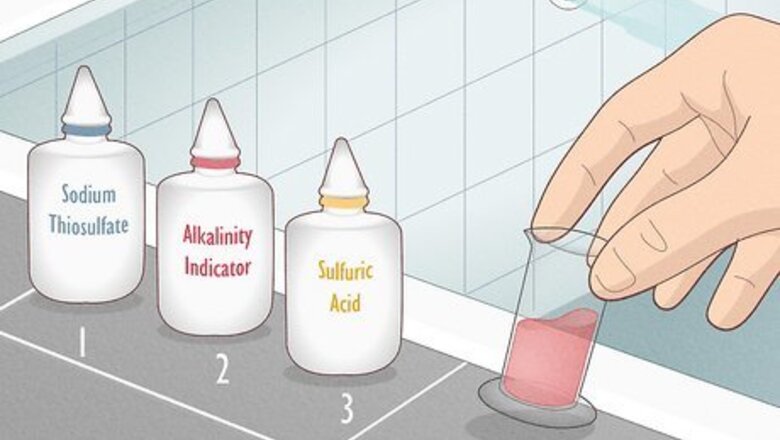
views
- Measure your pool’s alkalinity using a pool testing kit to see how far below the total alkalinity is beneath the standard 50 to 180 ppm (parts per million).
- Add 24 oz (680 g) lb baking soda to the pool water for every 10,000 gallons (37,854.12 L) of water to raise the alkalinity by 10 ppm.
- Add 6 oz (170 g) of soda ash for every 10,000 gallons (37,854.12 L) of water to raise the pH (and thus, the alkalinity) by 0.2.
- Routinely check the alkalinity at least once a week and the pH twice a day.
Baking Soda

Measure the pool’s alkalinity to see how much it needs to be raised. The alkalinity, or amount of alkaline in your pool, should be between 50 and 180 ppm (parts per million). You can measure this using the tools and liquid solutions included in a pool testing kit. The amount of baking soda you add will depend on how much you need to raise the alkalinity. To test the water, start by collecting a water sample in your tester that’s at least 18 in (45.7 cm) below the surface. Make sure the water reaches the “fill” line on the column of your tester. Add 2 drops of sodium thiosulfate to your sample and swirl the tube to mix. Then add 5 drops of the total alkalinity indicator. Swirl the tube to mix, and your water should now be green. Add the sulfuric acid reagent one drop at a time. Make sure to count each drop and swirl the mixture after each one. Stop adding drops when the water turns from green to red. Multiply the number of sulfuric acid reagent drops you added by 10 to get the total alkalinity in ppm.
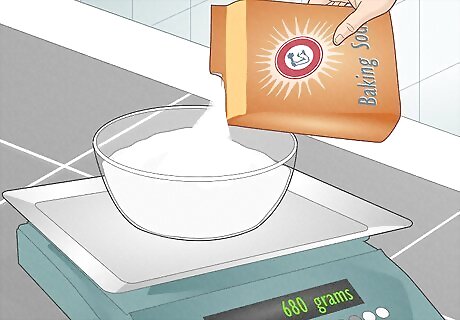
Add 24 oz (680 g) of baking soda per 10,000 gallons (37,854.12 L) of water to raise the alkalinity by 10 ppm. The amount of baking soda you'll need will be based off of how much water is in your pool and how much you need to raise the alkalinity. For a rectangular pool, calculate the volume in gallons by multiplying the pool’s average depth by its width and height, then multiplying the total by 7.48. For circular pools, calculate the volume by using the formula V = πr2h, with V being the volume, r the pool’s radius, and h the pool’s depth. Once you solve for V, multiply that by 7.48 to get the volume in gallons. Calculate how much baking soda you’ll need to raise the alkalinity by 10 ppm by using the formula ((Gallons of water in pool) / 10,000) x 24 = ounces of baking soda needed. If measuring in grams, replace 24 with 680. You can also purchase an alkalinity increaser to add to your pool. However, the main ingredient in these increasers is sodium bicarbonate, also known as...baking soda! So stick with just buying baking soda in bulk if you want a cheaper option.

Add the baking soda to the water and wait 6 hours for it to dissolve. Once you’ve measured out your baking soda, pour it into the water in a sweeping arc motion. This makes sure that the baking soda gets evenly distributed throughout the water. Then leave it to dissolve and spread around for about 6 hours. Keep the filter in your pool running during this time to help dissolve the baking soda and get it to spread around evenly. When dealing with baking soda, protect your skin and eyes by wearing rubber gloves and safety goggles.
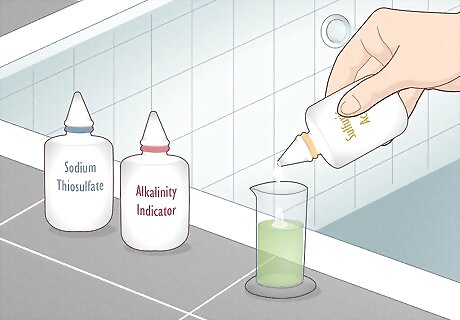
Test the alkalinity one more time. Conduct another test of the pool water to check whether the alkalinity is where you need it to be. If it still needs to be raised, repeat the previous steps until it's between 80 and 120 ppm. You can start adding more baking soda right away after you’ve finished testing the water.
Soda Ash

Measure the pool’s pH level. The purpose of soda ash is primarily to raise your pool’s pH along with the alkalinity. If the pH is below the standard 7.2, your alkalinity will also be low. The pH should be between 7.2 and 7.8. pH test kits come in two types: ones that use liquid solutions, and ones that use dissolving tablets. You can also use pH strips to test your water, but it will be less accurate. Compared to something like baking soda, soda ash will raise your pool’s pH levels pretty drastically. So if you’re only looking to raise the alkalinity without affecting the pH levels, it’s best to use baking soda rather than soda ash. For kits that use liquid solutions, gather a water sample at least 18 in (45.7 cm) below the water’s surface. Then add 1 drop of the sodium thiosulfate solution and swirl to mix it in. Add 5 drops of the phenol red indicator, swirl to mix, and compare the color of your water to the scale on the side to determine the pH level. For kits that use a dissolving tablet, simply drop the red phenol tablet into your water sample and shake vigorously until it dissolves. Compare the color of your water sample to the scale on the side to determine pH.
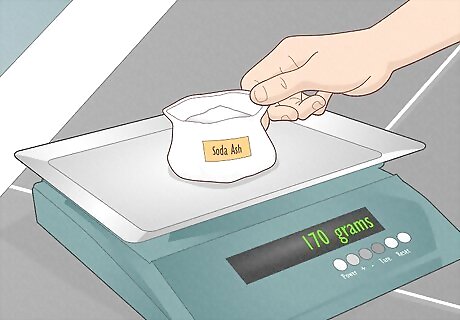
Add 6 oz (170 g) of soda ash for every 10,000 gallons (37,854 L) of water to raise pH by 0.2. Because soda ash affects pH more so than it does the alkalinity levels, base your soda ash measurements off of how much the pool’s pH needs to be raised. For a rectangular pool, calculate the volume in gallons by multiplying the pool’s average depth by its width and height, then multiplying the total by 7.48. For circular pools, calculate the volume by using the formula V = πr2h, with V being the volume, r the pool’s radius, and h the pool’s depth. Once you solve for V, multiply that by 7.48 to get the volume in gallons. Calculate how much soda ash you’ll need to raise the pH by 0.2 by using the formula ((Gallons of water in pool) / 10,000) x 6 = ounces of soda ash needed. If measuring in grams, replace 6 with 170. Wear rubber gloves and safety goggles to protect your skin and eyes from any possible irritation.

Dissolve the soda ash in a bucket of water before adding to the pool. Because the soda ash might not dissolve completely if directly poured into the pool, dissolve it in a bucket of water first before pouring it into the pool. Any size bucket and amount of water will work. Stir the soda ash in the bucket of water until it's completely dissolved, then walk around the perimeter of the pool while pouring in the soda ash water. Avoid pouring the mixture near the water filter. If it goes into the filter immediately, the filter is going to dilute it and make all of your previous hard work useless.

Leave the pool water to sit for 8 hours before testing again. Just because the soda ash has been dissolved doesn’t mean the pH and alkalinity will be raised just like that. Leave the mixture to spread evenly through the water and come back after about 8 hours to conduct a final chemical test. If the pH level and alkalinity are still low, repeat the previous steps until you’ve hit that sweet spot. Soda ash can turn the pool water cloudy if not completely dissolved, so leave your filter running to keep the water removing around during those 8 hours.
Maintaining Alkalinity
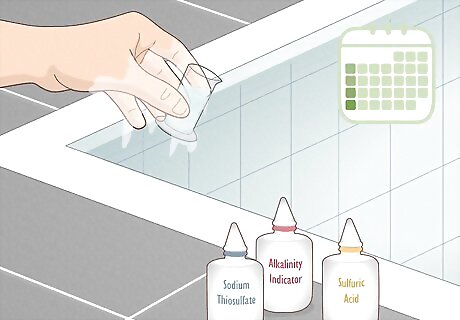
Test total alkalinity levels once a week. Regularly test your pool water using a pool testing kit to make sure that the total alkalinity, or the water’s resistance to changes in pH, is at a safe level. It shouldn't be less than 50 ppm (parts per million) or higher than 180 ppm. Rainwater flooding your pool is a common cause of low alkalinity, since the water becomes diluted. Other things such as acid rain, sweat, and even urine can also lead to low alkalinity levels.

Check pH levels twice a day. pH is the measure of a substance’s alkalinity or acidity, so measuring the pH can give you a clue as to whether your pool’s alkalinity is falling too low. The pH of the pool should always be somewhere between 7.2 and 7.8. You can test this using a pH testing kit.

Look out for cloudy water, corrosion, and algae. The alkaline in your pool does a lot to keep your pool water clear and keep it free of any bacteria or algae growth. Watch out for these signs to know when you need to be working on raising the alkalinity of your pool: Cloudy water Corrosion on ladders, pipes, or other metal parts Buildup of algae Irritated skin or eyes when swimming

Monitor for high alkalinity that can cause irritation and poor disinfection. If your pool’s alkalinity can be too low, then naturally, it can get to be too high at times as well. Signs that your alkalinity is too high include poor chlorine disinfection, eye irritation, and skin irritation. High alkalinity is mainly caused due to chlorine not fully oxidizing things in your pool.

















Comments
0 comment